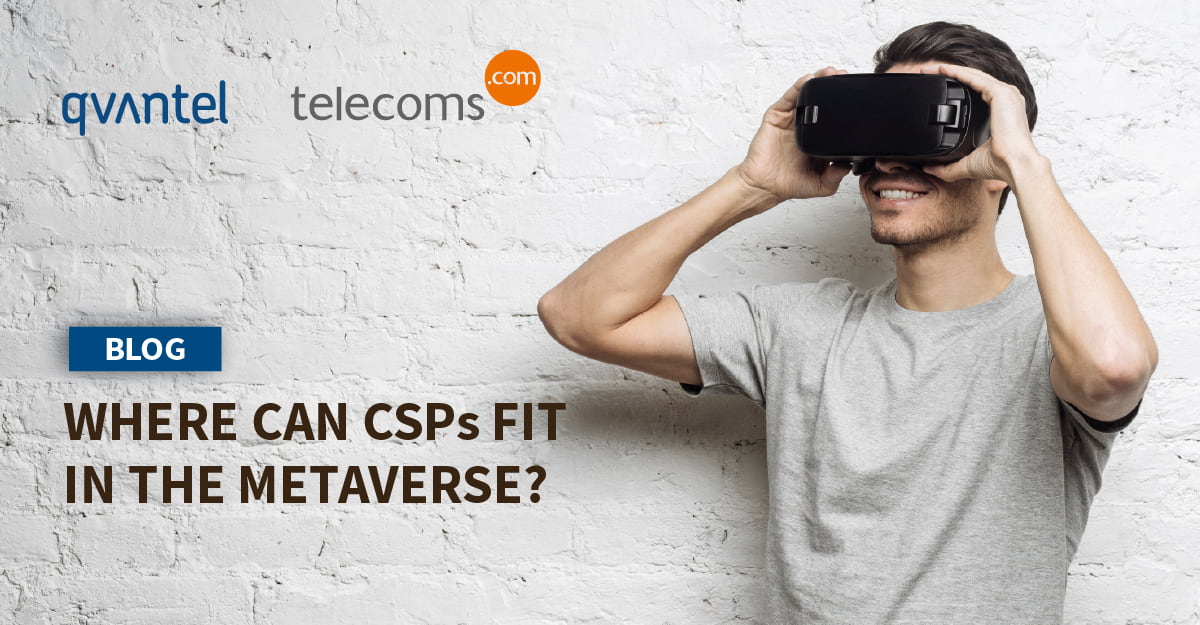
This article was first published on Telecoms.com.
Leading analyst firm Gartner described the Metaverse as the ‘next version of the internet’. In these shared and interconnected virtual 3D spaces people can work, play games, socialise, be entertained, shop, learn and do a lot of other stuff we do in a physical world – only it’s done virtually.
Bloomberg Intelligence predicts that the market for 3D virtual social worlds could be worth $800 billion by 2024. That’s only two years away and with numbers like this being quoted by analysts, it’s clear to see why a lot of heavyweight tech companies are getting interested in the Metaverse.
From a telecoms perspective, what does the Metaverse mean to CSPs? The obvious first answer is connectivity. The high speed and low latency delivered by fibre and 5G SA networks will be needed to enable Metaverse platforms to provide an immersive, smooth user experience – both for consumer services (VR gaming, events, social apps, and more) and for enterprise use cases (e.g. virtual events for employees, customer workshops, webinars, operating digital twins of the business, and more). The network slicing capabilities of 5G SA could allow for different latencies and speeds to support specific Metaverse platform applications and these can be tied into different retail and wholesale pricing plans supported by service level agreement for network performance.
But for some CSPs, they will want to go beyond being a connectivity provider. The recent news that Deutsche Telekom has teamed up with SK Telecom to bring the South Korean operator’s ifland Metaverse platform to Europe would perhaps tend to suggest that the Metaverse is going to be here a lot sooner than many people would have anticipated. SK Telecom launched ifland in July 2021 and it allows users to create avatars and set up virtual meetings ‘in a new world’. While the prospect of putting on a headset and transporting themselves to a ‘new world’ may seem very attractive to many people, there are many Metaverse use cases that could provide a new immersive and personalised dimension to many industries such as gaming, entertainment, retailing, sports and enterprise solutions. In the workplace, the ability to have virtual meetings where participants meet in the same virtual space, collaborate, share documents and videos in a meeting room environment could help bridge the creativity and collaboration gap that is emerging as more people choose to work from home post covid. Having a cozy, virtual space that looks and feels like the company’s identity and culture in the physical world could help to strengthen the employees’ feeling of belonging in the age of remote and hybrid work.
By building their own Metaverse platform, SK Telecom doesn’t want just to be a connectivity provider to the Metaverse platform providers. No doubt there will be a vast number of other companies providing Metaverse platforms and CSPs will provide the connectivity that powers these platforms. In other cases, CSPs will move beyond just providing connectivity and develop business partnerships with specialized companies of which solutions can be offered through CSPs – like virtual spaces for enterprises for more inspiring and impactful employee and customer engagement as mentioned above. The potential for new business models, personalised contextual advertising and upselling of services or content in the Metaverse is vast. There is also the potential to use the Metaverse as a channel for marketing for telecoms services and those of their business partners – e.g. upsell to a faster 5G speed tier, or buy the latest VR headset. In addition, the Metaverse could provide the channel with a next-gen, AI-driven customer care and service agent—to serve customers in these new digital touchpoints.
For CSPs there will be no one size fits all model for the Metaverse. Will many CSPs follow SK Telecoms’ lead and build their own Metaverse platform? Maybe some will, but according to a recent article by CNBC, Meta said that their Reality Labs division (the company designing applications for the Metaverse) have ‘devoted over $10bn to build the Metaverse’ and that the time between initial investment and profitability is going to be long. There may be a small handful of CSPs with deep pockets who build their own Metaverse platform. For the remainder, it will be a question of partnerships and going beyond providing ‘best effort’ connectivity. The Metaverse may well become a new and personalised virtual world for many and CSPs have an opportunity to evolve to play a role beyond connectivity providers.
There could be an opportunity for CSPs to supply the ‘business platforms that power Metaverse-based commerce. By ‘business platforms’ I mean using a combination of offer catalogs, billing, charging, partner management, care, sales and marketing. Think of it like a B2B2C marketplace on steroids, with CSPs taking a % of the financial transaction, such as people making purchases in the Metaverse and also from new business models, such as personalised advertising on the Metaverse or commerce enabled by digital currencies and NFTs (nonfungible tokens) for selling things like outfits and accessories for avatars, or digital art or decorations for virtual homes. Like 5G, Metaverse opens up new avenues for business innovation, which underlines the need from CSP business platforms to have a high degree of openness, adaptability, and flexibility for monetization use cases that are not even known yet well.
There are many, many questions about the Metaverse about regulation, interoperability, net neutrality and policing and (hopefully) these will be resolved relatively quickly. But the news that SK Telecom and Deutsche Telekom have joined up to bring SK Telecom’s ifland Metaverse platform to Europe suggests that perhaps the opportunities for CSPs to play a major role in this new arena will become reality sooner than expected.
Jukka Heiska
CMO
